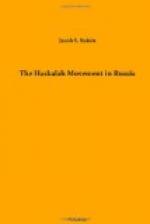The waves of the Renaissance and the Reformation sweeping over Russian Jewry reached even the sacred precincts of the synagogues, the batte midrashim, and the yeshibot. The Tree of Life College in Volozhin became a foster-home of Haskalah. The rendezvous of the brightest Russo-Jewish youths, it was the centre in which grew science and culture, and whence they were disseminated far and wide over the Pale. Hebrew, German, and Russian were surreptitiously studied and taught. Buckle and Spencer, Turgenief and Tolstoi were secretly passed from hand to hand, and read and studied with avidity. Some students advocated openly the transformation of the yeshibah into a rabbinical seminary on the order of the Berlin Hochschule. The new learning found an ardent supporter in Zebi Hirsh Dainov, “the Slutsker Maggid” (1832-1877), who preached Russification and Reformation from the pulpits of the synagogues, and whom the Society for the Promotion of Haskalah employed as its mouthpiece among the less advanced.[17] In the existing reform synagogues, in Riga, Odessa, Warsaw, and Vilna, and even in more conservative communities, sermons began to be preached in Russian. Solomon Zalkind Minor, who lectured in German, acquired a reputation as a preacher in Russian since his election to the rabbinate of Minsk (1860). He was called “the Jellinek of Russia” by the Maskilim.[18] Aaron Elijah Pumpyansky began to preach in Russian at Ponevezh, in Kovno (1861). Germanization at last gave way to Russification. Even in Odessa, where German culture predominated during the reign of Nicholas I, it was found necessary, for the sake of the younger generation, to elect, as associate to the German Doctor Schwabacher, Doctor Solomon Mandelkern to preach in Russian. Similar changes were made in other communities. In the Polish provinces the Reformation was making even greater strides. There the Jews, whether reform, like Doctor Marcus Jastrow, or orthodox like Rabbi Berish Meisels, identified themselves with the Poles, and participated in their cultural and political aspirations, which were frequently antagonistic to Russification. A society which called itself Poles of the Mosaic Persuasion was organized in Warsaw, an organ of extreme liberalism was founded in the weekly Israelita, and, with the election of Isaac Kramsztyk to the rabbinate, German was replaced (1852) by the native Polish as the language of the pulpit.




